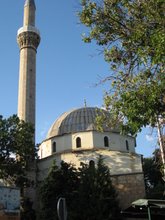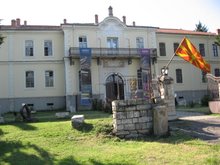This is my first visit to Bitola but not last ones! I hope that I manage to get closer to you this town its significancies, and its for sure worth to visit. While you are in Bitola you should certainly go to Pelister mountain, Struga, Skopje and Ohrid (a perfect place for soul and body) with aim to have complete vision of Macedonia.
I have enjoyed those two weeks in Bitola, and now through my Blog you enjoy it, too!
Wednesday, July 18, 2007
Bitola today
Bitola is the main economic and industrial center of southwestern Republic of Macedonia. Many of the largest companies in the Republic are based here. The Pelagonija agricultural combine is the largest producer of food in the country. The Streževo water system is the largest in the Republic of Macedonia and has the best technological facilities. The three thermoelectric power stations of REK Bitola produce nearly 80% of electricity in the state. The Frinko refrigerate factory is a leading electrical and metal company. Bitola also has significant capacity in the textile and food industries.
Heraclea Lyncestis
Heraclea Lyncestis (Greek: Ηράκλεια Λυγκηστίς - City of Hercules upon the Land of the Lynx) is an important settlement from the Hellenistic period till the Middle Ages. It was founded by Philip II of Macedon by the middle of the 4th century BC, and named after the Greek demigod Heracles, whom Philip considered his ancestor. As an important strategic point it became a prosperous city but the archaeological remains of this period are not widely researched. The Romans conquered this part of Macedon in 148 BC and destroyed the political power of the city. The prosperity continued mainly due to the Roman Via Egnatia road which passed near the city. Several monuments from the Roman times remain in Heraclea, including a portico, thermae (baths), an amphitheater and a number of basilicas. The theatre was once capable to house around 3,000 people.
Historical buildings
Saat Kula clock tower. It is not known when the clock tower was built. Written sources from the 16th century mention a clock tower, but it is not clear if it is the same one. Some believe it was built at the same time as St. Dimitrija Church, in 1830. Legend says that the Ottoman authorities collected around 60 000 eggs from nearby villages and mixed them in the mortar to make the walls stronger.The tower has a rectangular base and is about 30 meters high. Near the top is a rectangular terrace with an iron fence. On each side of the fence is an iron console construction which holds the lamps for lighting the clock. The clock is on the highest of three levels. The original clock was replaced during World War II with a working one, given by the Nazis because the city had maintained German graves from World War I.The massive tower is composed of walls, massive spiral stairs, wooden mezzanine constructions, pendentives (triangular pass from square to cupola) and cupola. During the construction of the tower, the facade was simultaneously decorated with simple stone plastic.
St. Dimitrija Church was built in 1830 with voluntary contributions of local merchants and craftsmen. It is plain on the outside, as all churches in the Ottoman Empie had to be, but of rare beauty inside, lavishly decorated with chandeliers, a carved bishop throne and an engraved iconostasis. According to some theories, the iconostasis is a work of the Miyak engravers. Its most impressive feature is the arc above the imperial quarters with modeled figures of Jesus and the apostles.Other engraved wood items include the bishop’s throne made in the spirit of Miyak engravers, several icon frames and five more-recent pillars shaped like thrones. The frescos originate from two periods: the end of the 19th century, and the end of World War I to the present. The icons and frescos were created thanks to voluntary contributions of local businessmen and citizens. The authors of many of the icons had a vast knowledge of iconography schemes of the New Testament. The icons show a great sense of color, dominated by red, green and ochra shades. The abundance of golden ornaments is noticeable and points to the presence of late - Byzantine artwork and baroque style. The icon of St. Dimitrij is signed with the initials "D. A. Z.", showing that it was made by iconographer Dimitar Andonov the zograph in 1889. There are many other items, including the putiri made by local masters, a darohranilka of Russian origin, and several paintings of scenes from the New Testament, brought from Jerusalem by pilgrims.
Ajdar-kadi (Turkish judge) mosque is one of the most attractive monuments of the Islamic architecture in Bitola. It was built in 1561-1562, as the project of the famous architect Mimar Sinan, ordered by the Bitola kadija Ajdar-kadi. Over time, it was abandoned and heavily damaged, but recent restoration and conservation has restored to some extent its original appearance.
Jeni mosque is located in the center of the city. It has a square base, topped with a cupola. Near the mosque is a minaret, 40 m high. Today, the mosque's rooms house permanent and temporary art exhibitions. Recent archaeological excavations have revealed that it has been built upon an old church.Ishak mosque is the inheritance of the famous kadi Ishak Celabi. In its spacious yard are several tombs, attractive because of the soft, molded shapes of the sarcophagi.
The bazaar (old market) is mentioned in a description of the city from the 16th and the 17th century. The present bezisten does not differ much in appearance from the original one. The bezisten had 86 shops and 4 large iron gates. The shops used to sell textiles, and today sell food products.
Bath Deboj is a Turkish bath (hamam). When it was constructed is not known. It was heavily destroyed, but after repairs it regained its original appearance: beautiful facade, two large cupolas and several minor ones.
St. Dimitrija Church was built in 1830 with voluntary contributions of local merchants and craftsmen. It is plain on the outside, as all churches in the Ottoman Empie had to be, but of rare beauty inside, lavishly decorated with chandeliers, a carved bishop throne and an engraved iconostasis. According to some theories, the iconostasis is a work of the Miyak engravers. Its most impressive feature is the arc above the imperial quarters with modeled figures of Jesus and the apostles.Other engraved wood items include the bishop’s throne made in the spirit of Miyak engravers, several icon frames and five more-recent pillars shaped like thrones. The frescos originate from two periods: the end of the 19th century, and the end of World War I to the present. The icons and frescos were created thanks to voluntary contributions of local businessmen and citizens. The authors of many of the icons had a vast knowledge of iconography schemes of the New Testament. The icons show a great sense of color, dominated by red, green and ochra shades. The abundance of golden ornaments is noticeable and points to the presence of late - Byzantine artwork and baroque style. The icon of St. Dimitrij is signed with the initials "D. A. Z.", showing that it was made by iconographer Dimitar Andonov the zograph in 1889. There are many other items, including the putiri made by local masters, a darohranilka of Russian origin, and several paintings of scenes from the New Testament, brought from Jerusalem by pilgrims.
Ajdar-kadi (Turkish judge) mosque is one of the most attractive monuments of the Islamic architecture in Bitola. It was built in 1561-1562, as the project of the famous architect Mimar Sinan, ordered by the Bitola kadija Ajdar-kadi. Over time, it was abandoned and heavily damaged, but recent restoration and conservation has restored to some extent its original appearance.
Jeni mosque is located in the center of the city. It has a square base, topped with a cupola. Near the mosque is a minaret, 40 m high. Today, the mosque's rooms house permanent and temporary art exhibitions. Recent archaeological excavations have revealed that it has been built upon an old church.Ishak mosque is the inheritance of the famous kadi Ishak Celabi. In its spacious yard are several tombs, attractive because of the soft, molded shapes of the sarcophagi.
The bazaar (old market) is mentioned in a description of the city from the 16th and the 17th century. The present bezisten does not differ much in appearance from the original one. The bezisten had 86 shops and 4 large iron gates. The shops used to sell textiles, and today sell food products.
Bath Deboj is a Turkish bath (hamam). When it was constructed is not known. It was heavily destroyed, but after repairs it regained its original appearance: beautiful facade, two large cupolas and several minor ones.
Tuesday, July 17, 2007
Bitola
Bitola is a city in the southwestern part of the Republic of Macedonia. It is an administrative, cultural, industrial, commercial and educational centre. It is located in the southern part of the Pelagonia valley, surrounded by the Baba and Nidze mountains, 14 km north of the Medžitlija-Niki border crossing with Greece. It is an important junction connecting the south of the Adriatic Sea with the Aegean Sea and Central Europe. It is known from the Ottoman period as "the city of the consuls", as many European countries had consulates in Bitola. According to some sources Bitola is the second largest town in the country and by others the third. Bitola is also centre of the Bitola municipality.
Monday, July 16, 2007
Bitola tour
I will indroduce you with the Bitola town. I hope you will enjoy as I was. Those are the places I am warmly recomending for visit.
Information
One of these boards is mounted in front of the Officers Club and the other in front of the Art Gallery. On these boards you can get information about the location of the Tourist Information Center and a map of the city with the most important cultural and historical monuments that are found on the so called Golden line.The boards that are going to be placed at the three entrances of the city besides the location of the TIC, there will be a drawing of the bordering municipalities of Bitola.
Subscribe to:
Comments (Atom)












